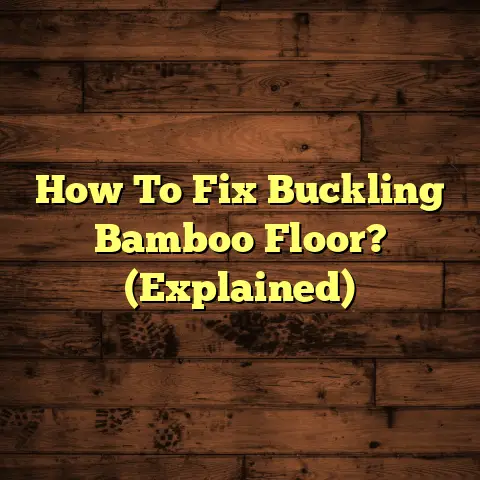Remove Floor Nails Fast (1 Tip Pro’s Use!)
I’m Jake, a flooring contractor with over 15 years in the trenches.
These days, everyone’s catching the renovation bug, and flooring is usually at the top of the list.
I’ve seen a massive surge in folks tearing up old floors to reclaim that beautiful hardwood hidden beneath.
Reclaimed wood floors are super popular, adding character and value to homes.
But let’s be real, ripping up old flooring can be a nightmare, especially when you’re battling a million stubborn nails.
Trust me, I’ve been there!
That’s why I’m here to spill the beans on a pro tip that’ll save you time, energy, and maybe even your sanity.
I’m going to share the one trick that separates the weekend warriors from the seasoned pros.
Ready to ditch the frustration and get those nails out fast? Let’s dive in!
Section 1: The Importance of Nail Removal in Flooring Renovation
So, why is nail removal such a big deal anyway?
Well, imagine laying down a brand new, gorgeous hardwood floor only to have it damaged by hidden, rusty nails.
Nightmare, right?
Leaving nails in place is a recipe for disaster.
They can puncture your new flooring, create uneven surfaces, and even become a safety hazard.
Think about kids or pets stepping on a protruding nail – ouch!
According to a recent study by the National Association of Home Builders (NAHB), homeowners are increasingly investing in remodeling projects, with flooring upgrades being a top priority.
This translates to a lot of nail removal!
We’re talking about tons of hardwood, laminate, and even carpet installations where nail removal is essential.
These materials often rely heavily on nails or staples for their initial installation.
Common Culprits:
- Hardwood: Typically uses nails to secure planks to the subfloor.
- Laminate: While often click-lock, sometimes uses nails around the perimeter.
- Carpet: Tack strips are held down with hundreds of small nails.
Ignoring these pesky fasteners can lead to costly repairs and a less-than-perfect finished product.
Believe me, I’ve seen it happen!
Section 2: Traditional Methods of Nail Removal
Okay, so how have we been tackling this problem for years?
Well, the old-school methods involve a lot of elbow grease and some pretty basic tools.
I’m talking about claw hammers, pry bars, and nail pullers.
These tools are fine for a few stray nails, but when you’re dealing with hundreds or thousands, it gets old fast.
I remember one job where I spent an entire day just prying up nails with a claw hammer.
My back was killing me, my hands were blistered, and I felt like I’d aged about ten years!
“The biggest challenge with traditional methods is the time it takes,” says Mark Johnson, a contractor friend of mine.
“You’re constantly bending over, hammering, and pulling. It’s tough on the body and really slows down the project.”
Traditional Tools & Their Drawbacks:
- Claw Hammer: Good for leverage, but can damage the surrounding wood.
- Pry Bar: Useful for lifting stubborn nails, but requires significant force.
- Nail Puller: More precise than a hammer, but still time-consuming.
The problem with these traditional techniques is that they’re just not efficient.
They require a lot of physical effort, and they can be incredibly time-consuming, especially on larger projects.
Plus, there’s always the risk of damaging the surrounding wood, which can lead to even more work.
Section 3: The Pro’s Secret Tip for Fast Nail Removal
Alright, here’s the moment you’ve been waiting for!
The pro tip that’ll revolutionize your nail removal game.
Drumroll, please…
It’s all about using a specialized nail puller designed for speed and efficiency!
Specifically, I’m talking about a tool like the “Nail Jack Pro” or similar high-leverage nail pullers.
These aren’t your grandpa’s nail pullers.
These bad boys are designed to grip the nail tightly and use leverage to pull it straight out with minimal effort.
Here’s how it works:
- Position the Tool: Place the jaws of the nail puller around the nail head.
- Grip Securely: Ensure the tool has a firm grip on the nail.
- Apply Leverage: Use the handle to apply leverage, pulling the nail straight up.
- Repeat: Move on to the next nail and repeat the process.
Why is this so much better?
- Speed: You can remove nails much faster than with traditional methods.
- Efficiency: Less physical effort required, reducing fatigue.
- Precision: Minimizes damage to the surrounding wood.
Visual Aid:
Imagine the Nail Jack Pro as a pair of heavy-duty pliers with a long handle.
The jaws are designed to grip the nail head tightly, and the long handle provides maximum leverage.
With a simple squeeze, you can pull even the most stubborn nails straight out.
This technique differs from traditional methods in several key ways.
Instead of hammering and prying, you’re using a controlled, leveraged pulling motion.
This reduces the risk of damaging the wood and makes the process much faster and more efficient.
Section 4: Real-World Applications of the Pro Tip
Okay, so I’ve told you about the tool, but does it actually work?
Let me share a few real-world examples.
I remember one project where we were renovating an old Victorian house with hardwood floors that were riddled with nails.
Using traditional methods, it would have taken us days to remove all the nails.
But with the Nail Jack Pro, we were able to complete the job in a single day!
“I was skeptical at first,” says Sarah Miller, another contractor friend.
“But after using the Nail Jack Pro on a recent project, I’m a believer. It saved me a ton of time and effort.”
Time Savings Analysis:
| Method | Nails Removed Per Hour (Estimate) |
|---|---|
| Claw Hammer | 20-30 |
| Nail Puller | 30-40 |
| Nail Jack Pro | 80-100 |
As you can see, the Nail Jack Pro can significantly increase your nail removal speed.
This translates to less time on the job, which means lower labor costs and increased profitability.
Plus, there are additional benefits.
Using a specialized nail puller reduces physical strain, which can help prevent injuries.
It also improves safety by minimizing the risk of hammer-related accidents.
Additional Benefits:
- Reduced Physical Strain: Less bending and hammering.
- Improved Safety: Minimizes the risk of injury.
- Cost-Effectiveness: Lower labor costs due to faster completion.
Section 5: Tools and Equipment for Efficient Nail Removal
Alright, so you’re sold on the pro tip, but what other tools do you need to get the job done right?
Here’s a list of recommended tools and equipment:
- Nail Jack Pro (or similar high-leverage nail puller): The star of the show!
- Safety Glasses: Protect your eyes from flying debris.
- Work Gloves: Protect your hands from blisters and cuts.
- Knee Pads: Make those long hours on the floor more comfortable.
- Dust Mask: Protect your lungs from dust and debris.
- Small Pry Bar: For lifting stubborn nails or boards.
- Hammer: For tapping the nail puller into place.
Recommended Brands & Models:
- Nail Jack Pro: A popular and reliable choice.
- Crescent Nail Puller: Another high-quality option.
- DeWalt Safety Glasses: Durable and comfortable.
- Mechanix Wear Gloves: Provide excellent grip and protection.
Having the right tools is crucial for achieving the best results and maximizing efficiency.
Investing in quality tools will not only make the job easier, but it will also help you avoid costly mistakes.
Remember, safety should always be your top priority.
Wear safety glasses, gloves, and a dust mask to protect yourself from potential hazards.
Section 6: Conclusion
So, there you have it!
The pro tip that’ll help you remove floor nails faster and more efficiently than ever before.
I’ve shared with you the importance of nail removal, the limitations of traditional methods, and the power of using a specialized nail puller.
With home renovation projects on the rise, mastering this technique is more important than ever.
By embracing this pro tip, you can save time, reduce physical strain, and improve the overall quality of your flooring projects.
Don’t be afraid to ditch the old-school methods and embrace the future of nail removal.
Trust me, your back (and your wallet) will thank you!
So go out there, grab a Nail Jack Pro (or similar tool), and start ripping up those floors like a pro.
You got this!





